1lumen selects and reviews products personally. We may earn affiliate commissions through our links, which help support our testing.
Mateminco PD90S review
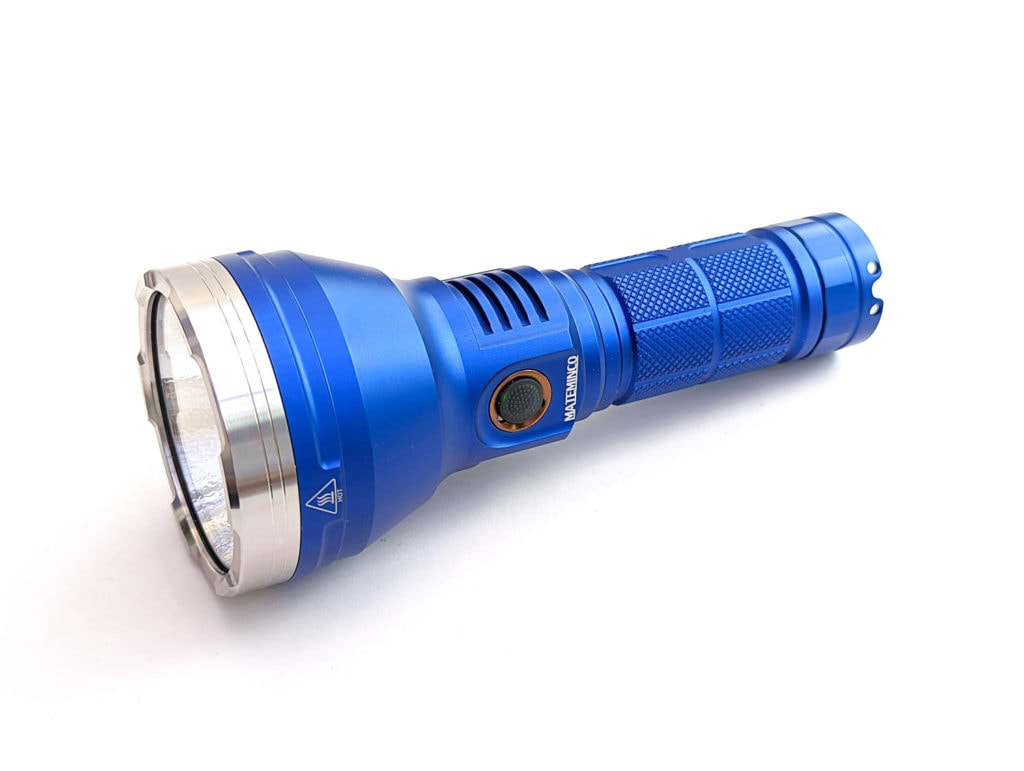
Mateminco PD90S specifications
| Brand/model | Mateminco PD90S |
|---|---|
| LED | SFH55 |
| Max. Lumens | 9,300 lm |
| Max. Beam intensity / distance | 213,750 cd / 924 meters |
| Battery config. | 1*26650 |
| Onboard charging | USB-C |
| Modes | Many (Anduril) |
| Blinkies | Many (Anduril) |
| Reflector | OP |
| Waterproof | IPX7 |
| Review date | April 2022 |
Introduction:
The Mateminco PD90S may look very familiar. It’s the same host as the Mateminco MT90 Mini, MT70 Mini, and the Astrolux FT03 / FT03S. I have quite a few Astrolux flashlights that are made by Mateminco as the OEM but this is the first one with their branding that I have.
We’ve reviewed a few of these before:
- Astrolux FT03S Copper with SBT90.2
- Astrolux FT03S with SBT90.2
- Astrolux FT03 with SST40
This host has been very successful, producing good throw distance in a reasonable size flashlight and at a good price point. The success has meant it’s had many variations in a similar way to the Convoy S2/S2+, which has a million different LED combinations. The PD90S has more lumens than any other light using the same host, so this version is very much my kind of flashlight.
The lumens come from the use of the new SFH55 LED, from the same unknown manufacturer as the SFN55.2 in the Nightwatch NI03 Valkyrie and Lumintop D3 that Nick reviewed.
Package quality.
Nothing too fancy here: just a brown cardboard box with a foam insert. Inside the box is just the basics:
- Mateminco PD90S flashlight
- Manual (mine mentions the MT90 mini version but they all work the same)
- Lanyard
- 2 spare o-rings
- Cell adaptor (18650 to 26650)
The light doesn’t come with a battery: you’ll need a single 18650, 21700, or 26650 size cell for it to work.
There’s also no USB cable in the box. You’ll need a USB-C cable unless you plan to charge cells on a dedicated charger.

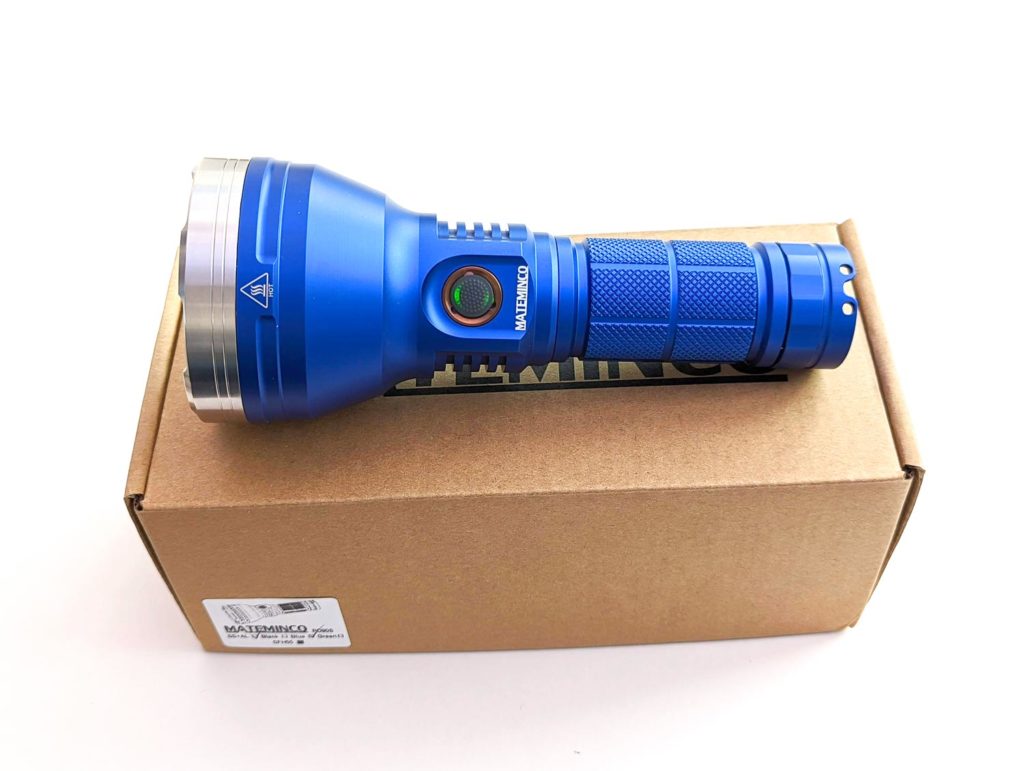
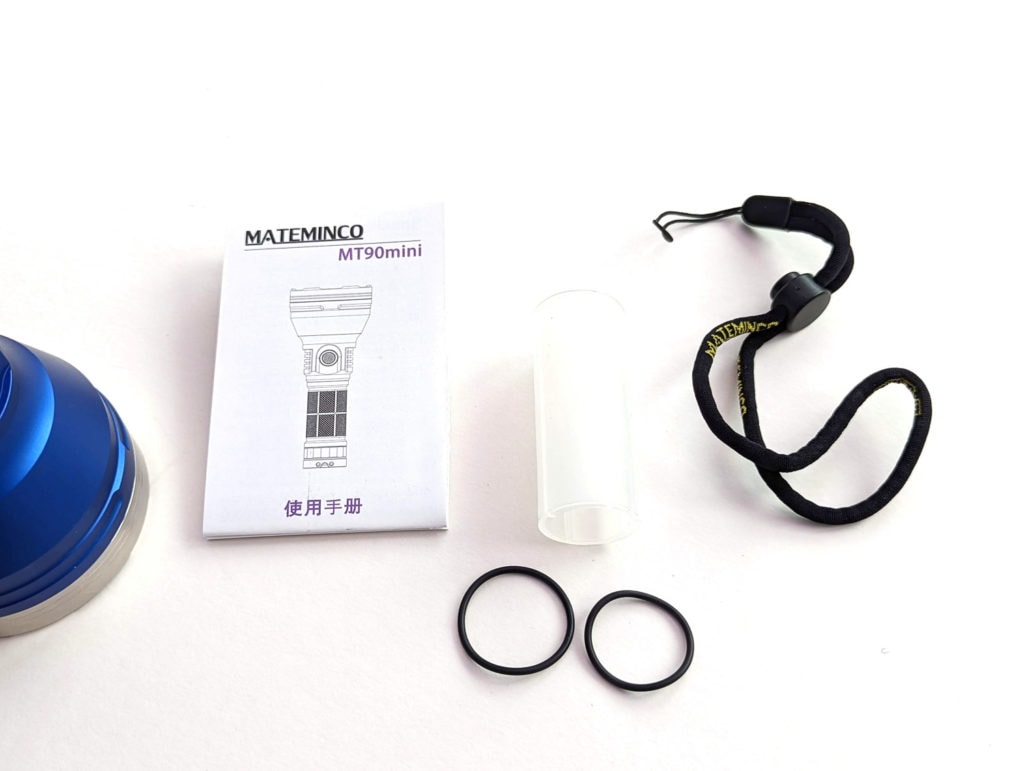
Flashlight in use
The Mateminco PD90S is a proper “flashlight-shaped” flashlight. When you pick it up, it feels well proportioned and about as big as you can comfortably hold with 1 hand. The light will fit in some jacket pockets but with a large head and long body, it’s bigger than the average light I’d normally carry. You could carry the PD90S in a compatible holster if your pockets aren’t big enough.
My thumb naturally rests on the side e-switch, which has a good click action. The knurling on the body tube is a little rough but serves as good grip.
The light will headstand on the bezel, with the crenelations allowing you to see if you left the light on. It will tail stand too, even with the lanyard attached through the holes in the tailcap. The light rolls when on its side, which is annoying when taking review photos! There’s no tripod mount hole.
Being a single cell light, you can mount the light on a bike handlebars pretty easily. 9300 lumens is a bit much for riding on roads but could come in handy offroad.
I can imagine using the PD90S to quickly search around a farm or on a night hike. For proper search and rescue, I’d recommend a multi-cell light for more runtime.
Thanks to the lowest mode being very low, you could use the PD90S indoors or as a night light.
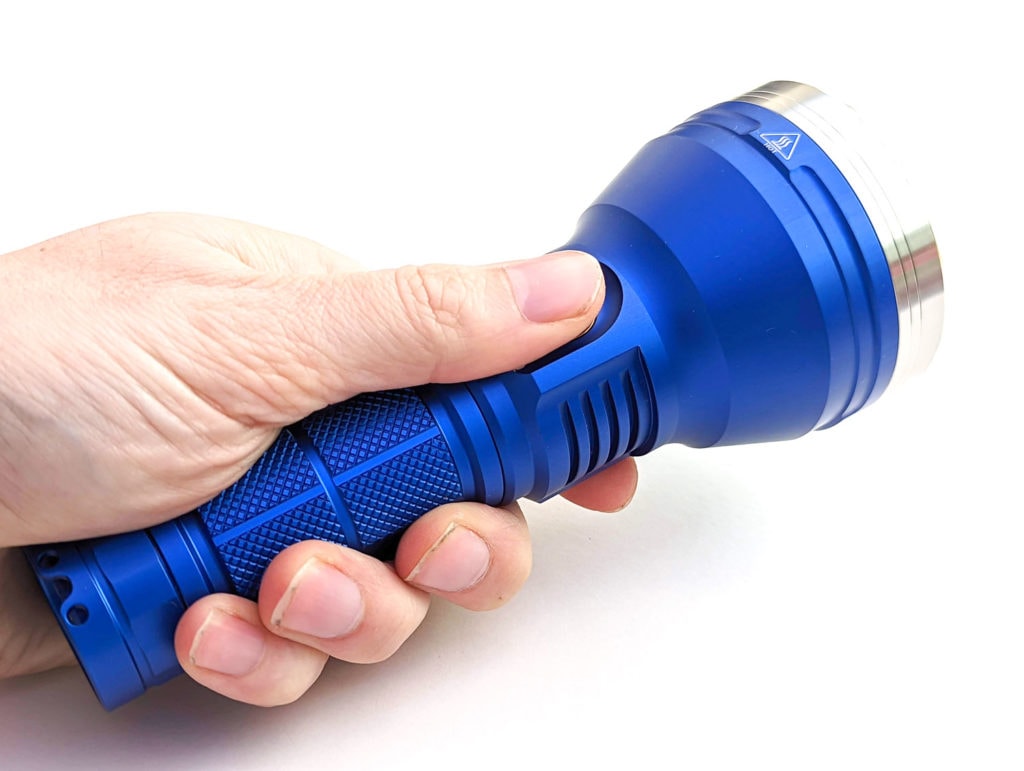
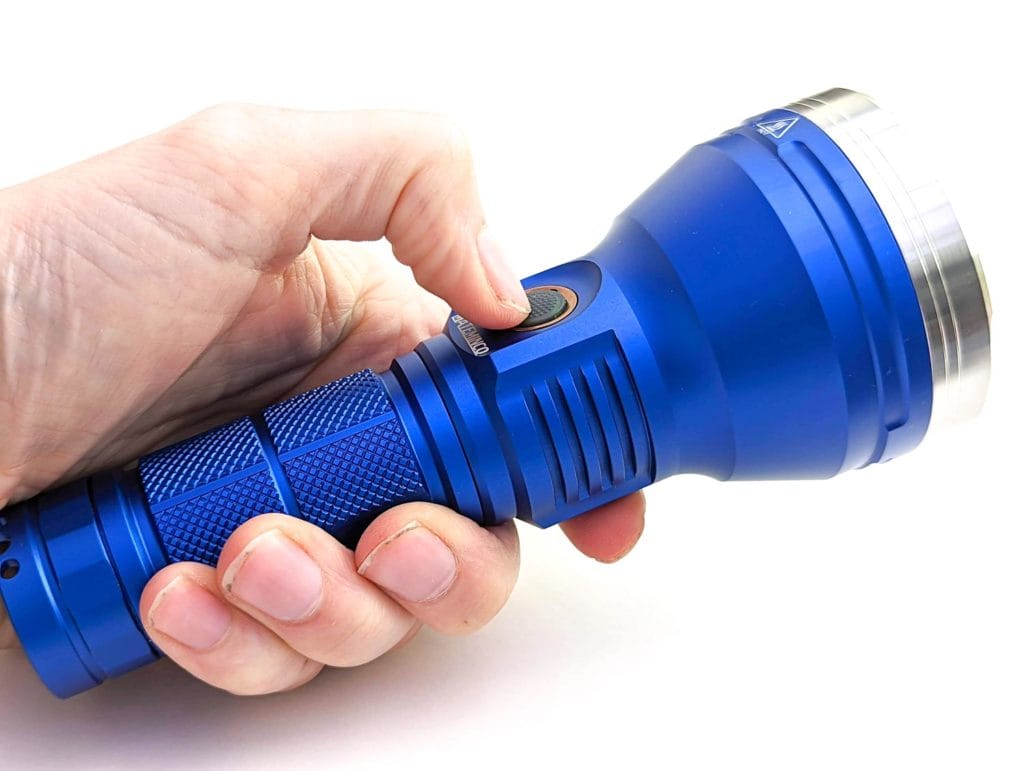
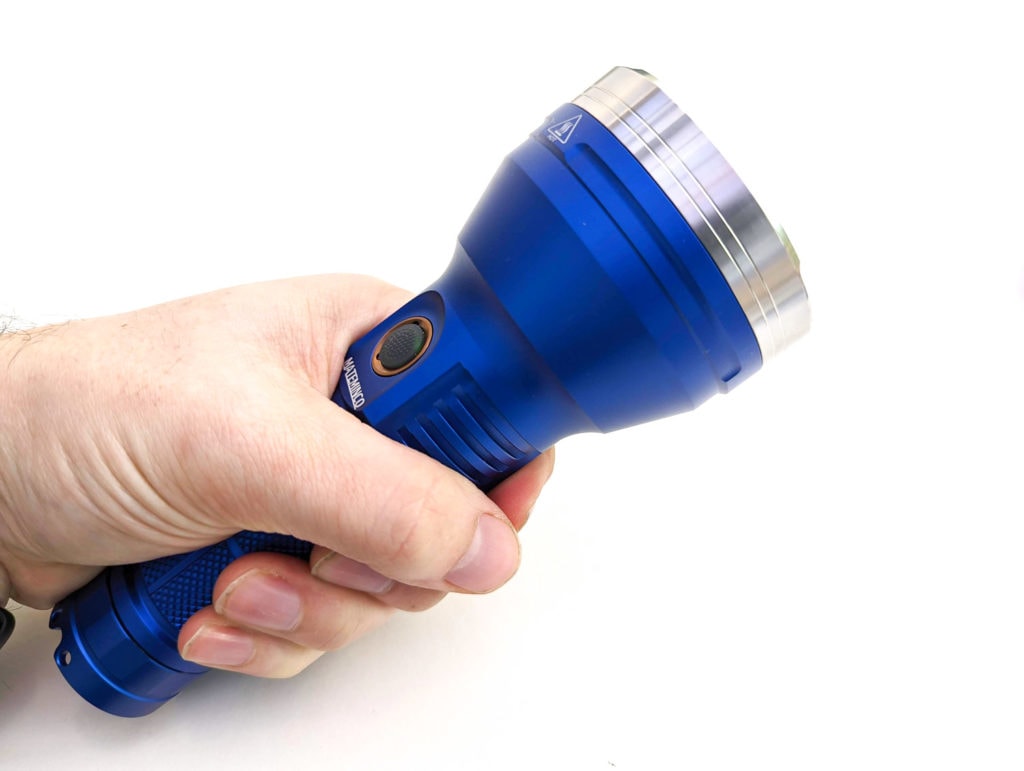
Build Quality, and Warranty
Mateminco is definitely on the budget end of manufacturers but the host of the PD90S / MT90 Mini / FT03 / whatever you want to call it is great: good, even anodising, and no rough edges. The threads are trapeze cut and have just about enough lube.
My review sample has a lovely blue color anodisation, which stands out nicely in my sea of boring black flashlights.
The light is pretty solid, with a thick aluminum body tube, hefty dual springs, and a good weight to it.
Warranty: I can’t find any warranty information from Mateminco, so double check what the seller provides.
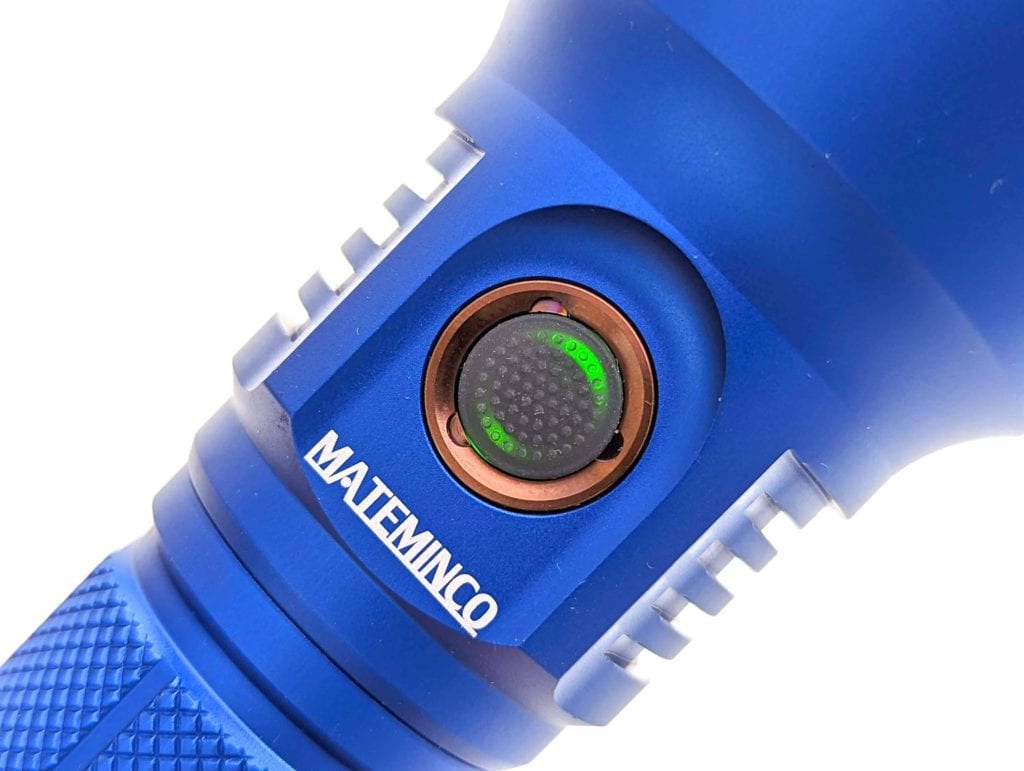
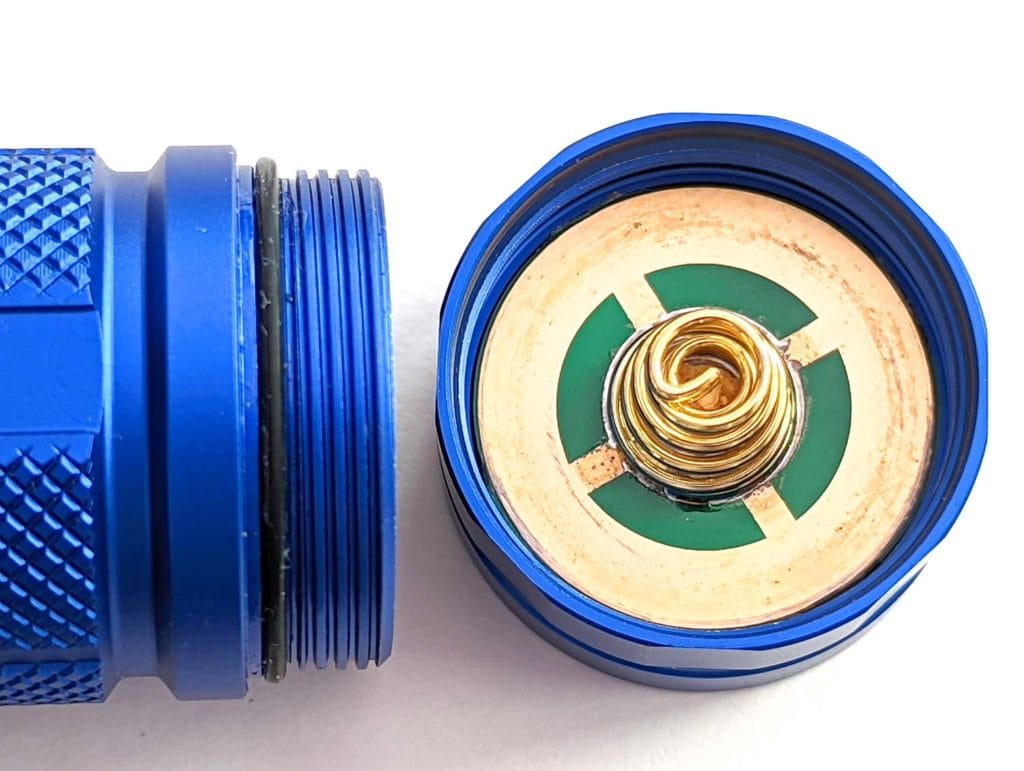
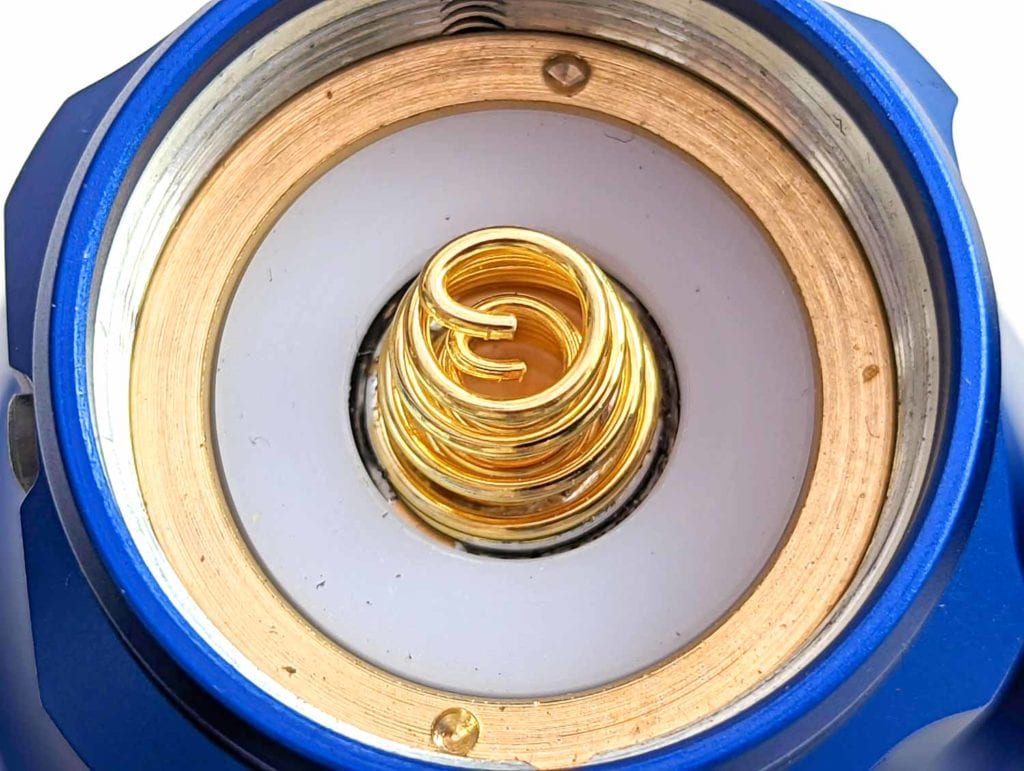
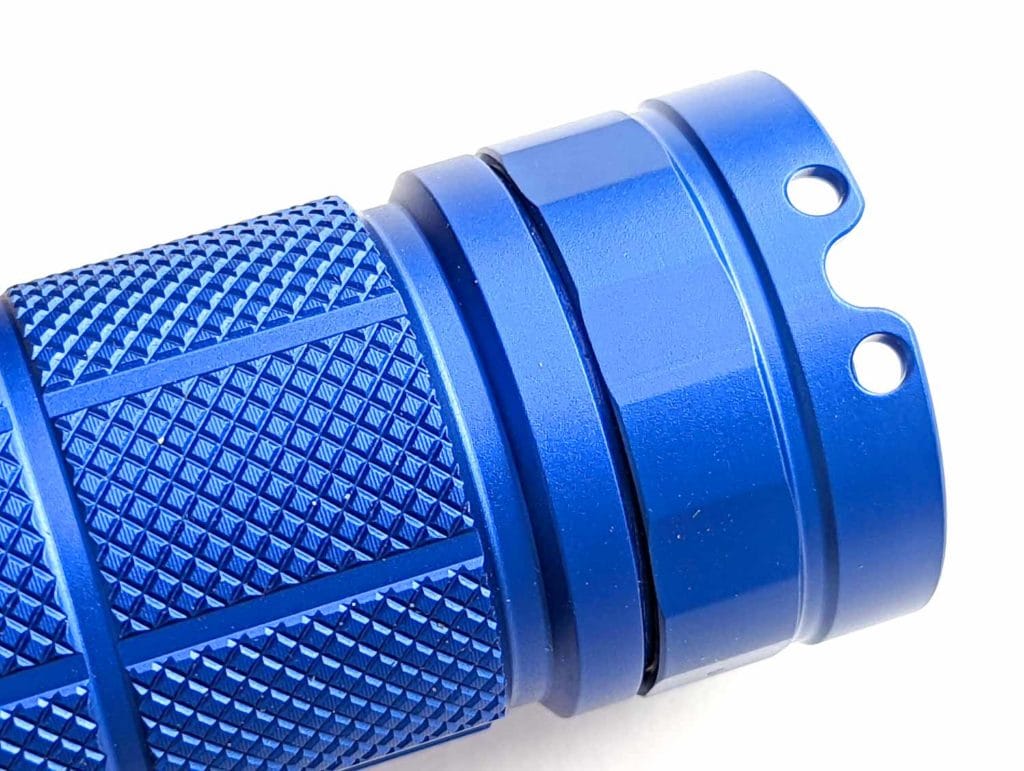
LED, Lens, Bezel, Beam, and Reflector
You can get this light with a few LED options, aside from the massive SFN55. Here’s the claimed specs of each one, along with the calculated candela per lumen:
| LED | Lumens | Throw | Candela | Candela per lumen (cd / lm) |
| SFH55 | 9300 | 924m | 214 kcd | 23 |
| SFN55.2 | 6800 | 1000m | 250 kcd | 37 |
| SBT90.2 | 4500 | 1428m | 510 kcd | 113 |
| XHP50.2 | 4300 | 735m | 133 kcd | 31 |
| SST40 | 2400 | 875m | 190 kcd | 79 |
| SFT40 | 2200 | 1200m | 413 kcd | 188 |
From this, you can see that the SFH55 is the brightest and most floody. It only out-throws the XHP50.2 and SST40 but only due to brute force. That means that after turbo steps down to a more sustainable level, the other LED versions will throw much further.
At 23 candela per lumen, it is still a moderately throwy flashlight, with a similar beam profile to my Manker MC13 90.2 and Astrolux FT02S with SST40 LEDs.
The LED itself is cool white and has low CRI. The Opple Light Master Pro showed a slightly green tint but to my eyes, it’s actually a pretty good tint, even from hotspot to spill
- 6327K
- 68 CRI
- DUV: 0.0041
Aside from the LED, we have an orange peel reflector and a nice stainless steel bezel.
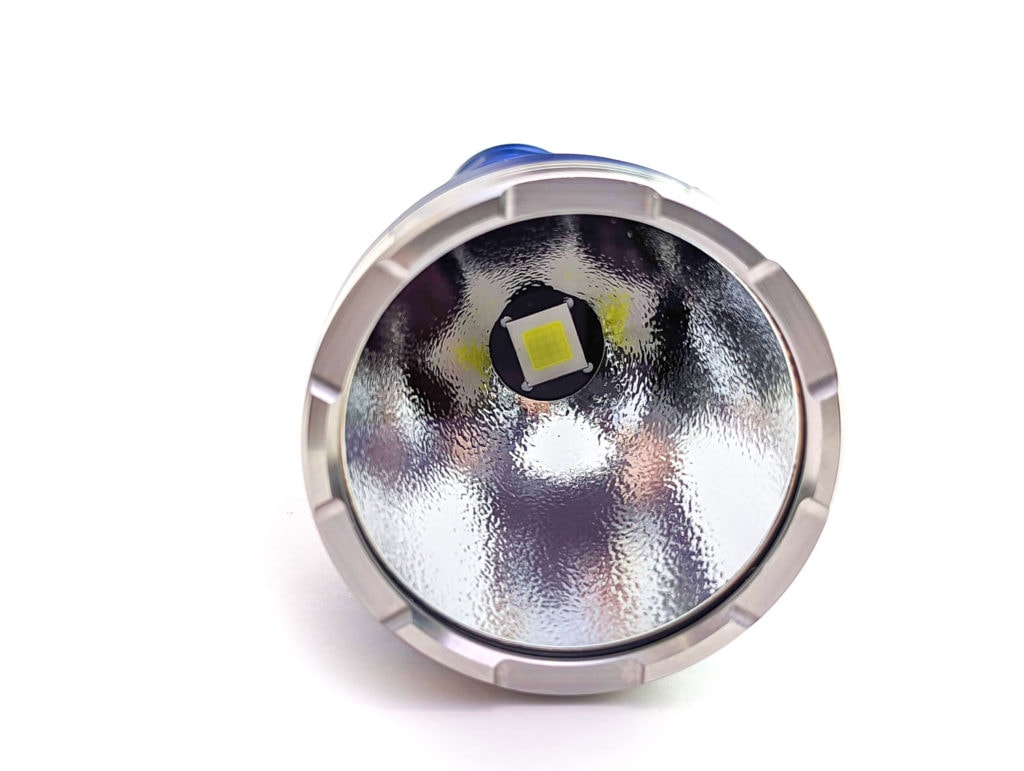
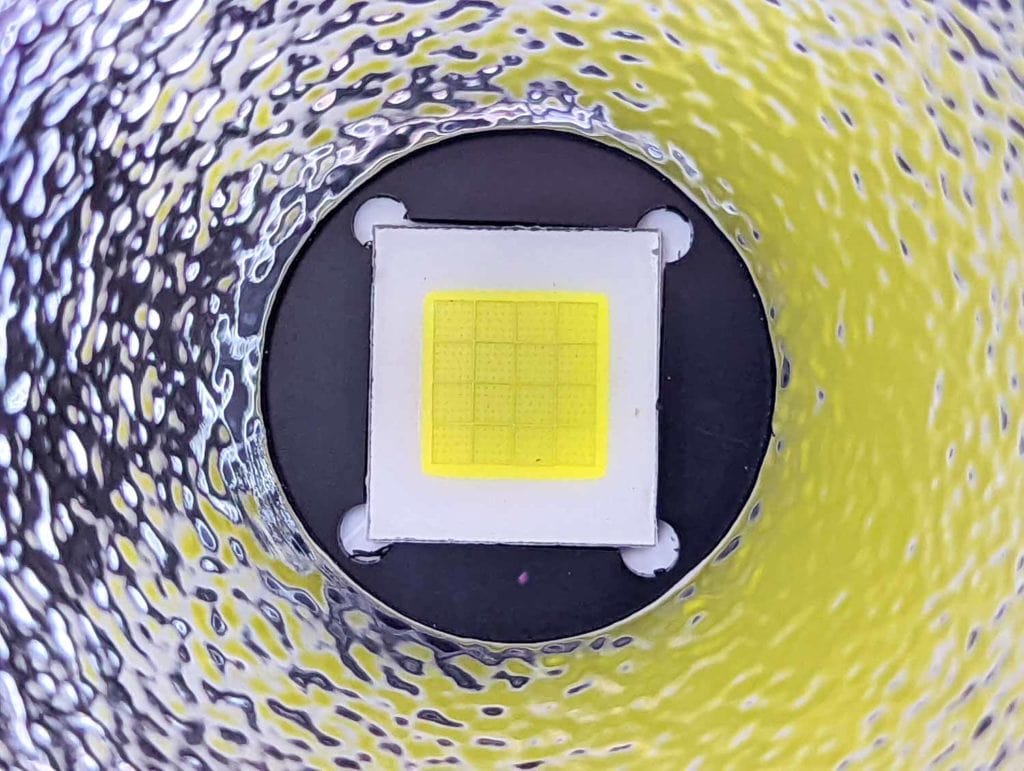
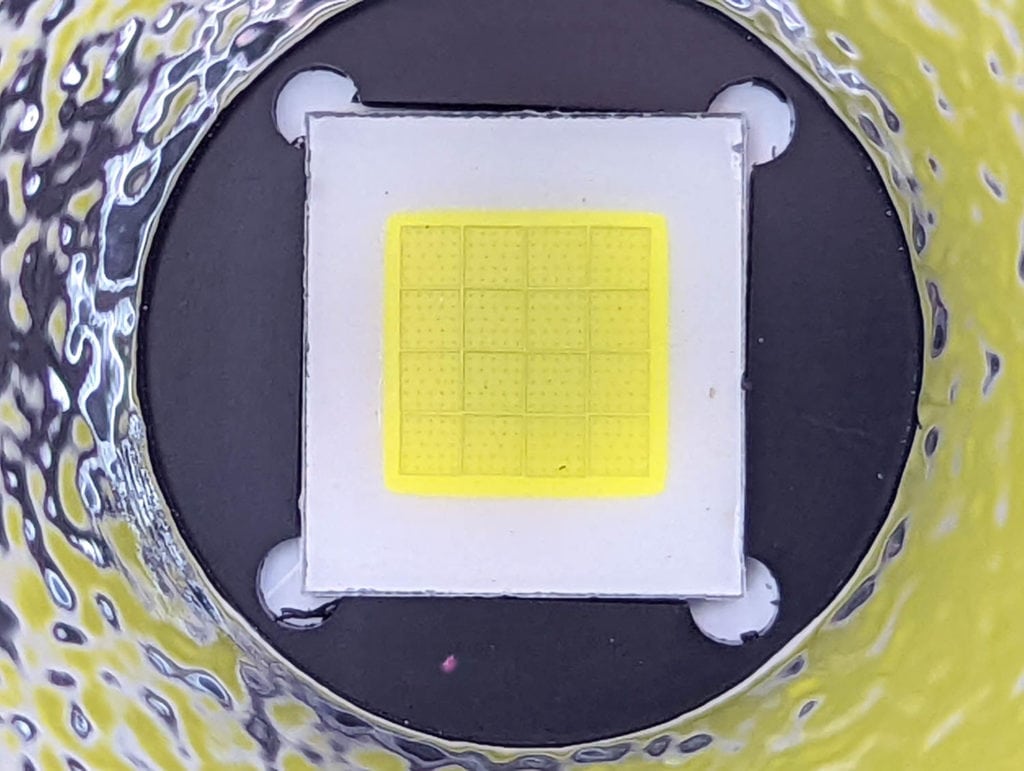
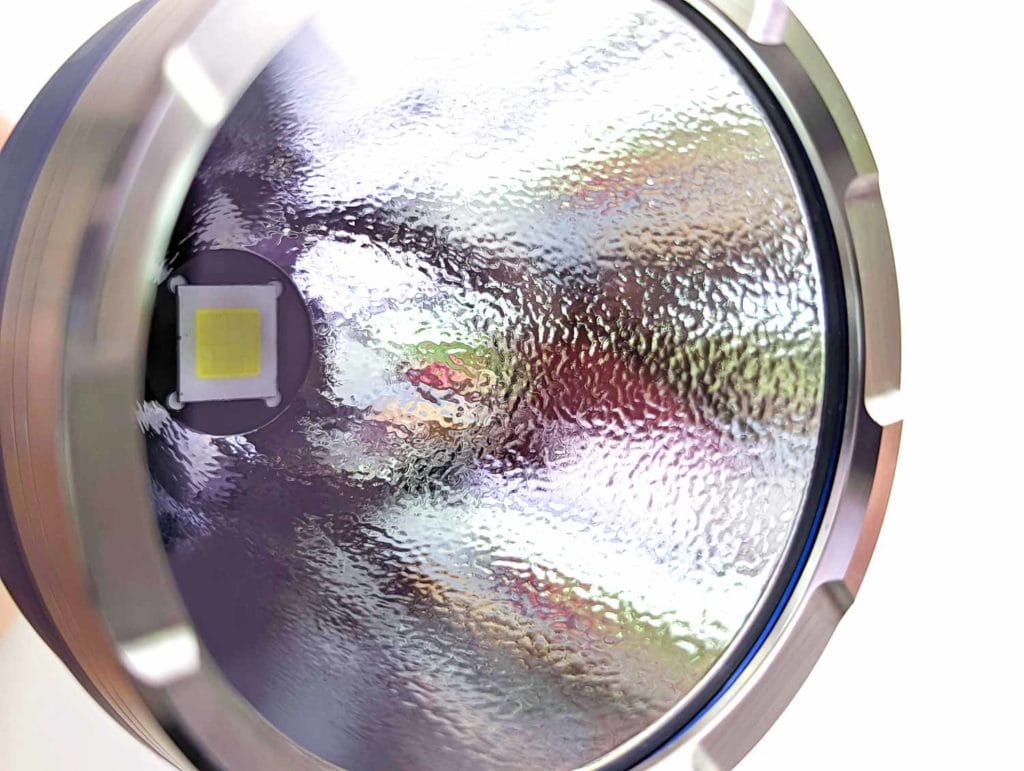

Dimensions and size comparison
Length:
- Length: 17.0 cm / 6.7 inches
- Head diameter: 6.90 cm / 2.71 inches
- Body diameter: 3.44 cm / 1.35 inches
Weight:
- Without cell: 321 grams / 11.3 oz.
- With cell: 390 grams / 13.8 oz.
Flashlight comparison
Size compared to other high power thrower flashlights
- Astrolux FT02S
- Astrolux FT03
- Mateminco PD90S
- Acebeam K30-GT
- Manker MC13 90.2
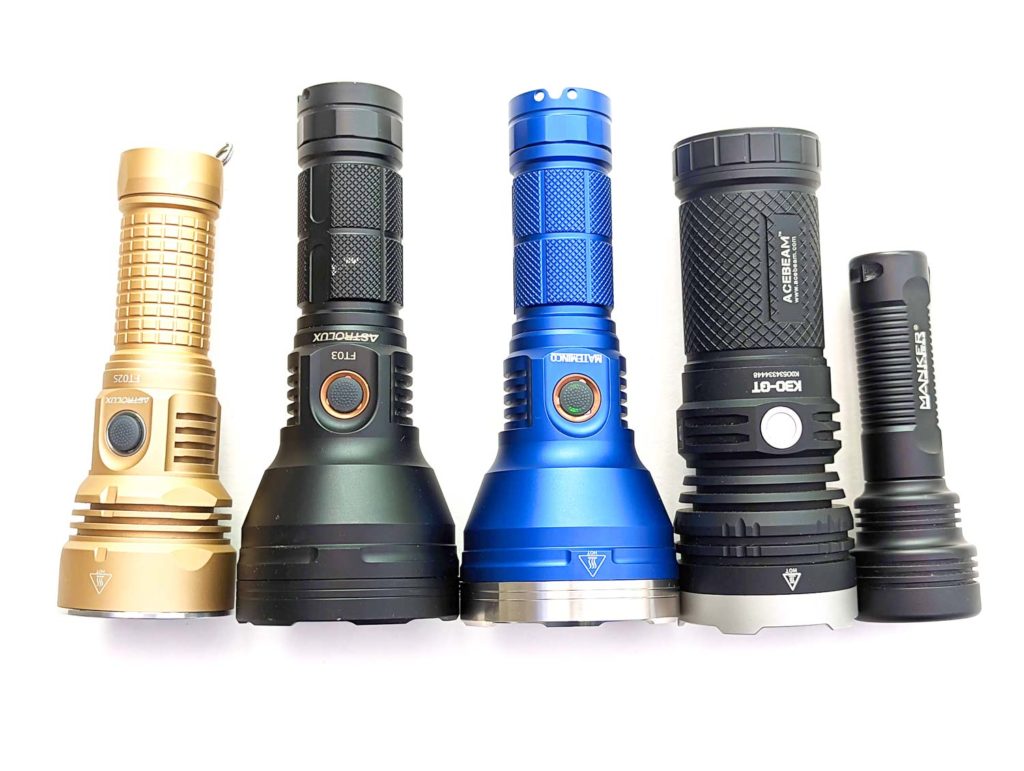
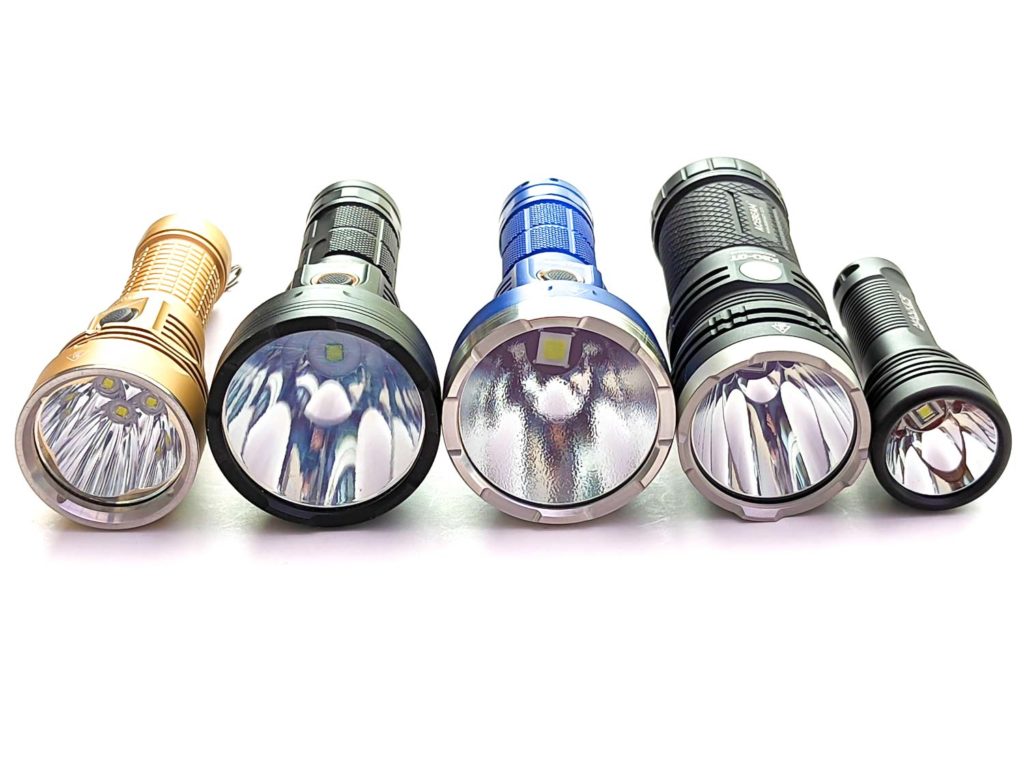
Driver & User Interface:
Check out the full Anduril UI manual here.
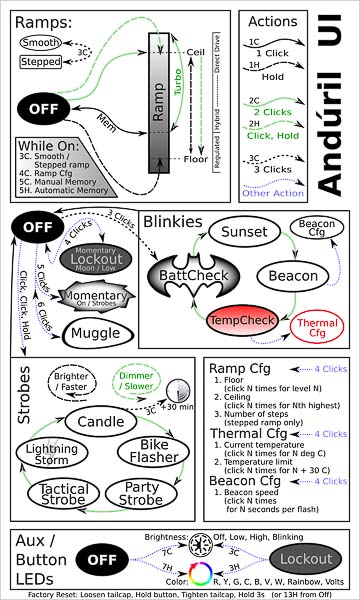
From OFF:
- Single-click: ON
- Double click: High
- 3 clicks: Battery check
- 4 clicks: Lock Out
- 5 clicks: Momentary On
- 6 clicks: Muggle mode
Enter Special/Fun modes from OFF:
- 2 clicks + hold: Strobe modes (Click, Click, Click and hold)
- 4 clicks: Lock Out mode (momentary on: dim)
- 5 clicks: momentary mode (Bright) ( you can only deactivate by breaking electrical contact between the batteries and the driver by unscrewing the body from the head.
- 6 clicks: Muggle mode
From ON:
- Single-click: Off
- Double click: Turbo
- 3 clicks: change ramping mode. Instead of a smooth increase, it has 6 little steps between Low and Max.
- 4 clicks: ramping configuration mode (Problematic if you make some changes here by accident)
- Press and hold: brightness ramps up.. release and press and hold again to ramp down.
SPECIAL AND FUN MODES:
Read the full manual on how to access and customize these modes. Also, see the firmware picture.
- Blinky Utility mode:
- Battery check
- Sunset Mode
- Beacon mode
- Temperature check
- Strobe / Mood modes:
- Candle
- Bike flasher
- Party strobe
- Tactical Strobe
- Lightning mode
- Lockout mode (can’t use the light) (activate by 4 clicks)
- Momentary mode (signaling/morse coding)
- Muggle mode: (safer for children)
- Configuration mode
- Ramp config mode
LOCK OUT FEATURE:
- From OFF: 4 clicks. To deactivate click another 4 times.
Additional info:
- As with most versions of this host, it uses an older version of Anduril from 2019. It includes the factory reset function but not the version check.
- The driver appears to be FET+1
Batteries & Charging
One thing I like about lights like the PD90S is that you can choose between using a 18650, 21700, or 26650 cell. 26650 are the best fit but you can use the provided adaptor to use an 18650 cell. Flat top 21700 cells just fit, thanks to the springs at each end. There’s no adaptor for these though, so I’d recommend a couple of O-rings or similar to stop it from moving around. Longer 21700 cells like protected ones might just fit but I’d recommend against them as they could damage the springs. Protected or button top 26650 or 18650 cells would be fine.
Charging via the built-in USB-C port works great. You’ll need an A-to-C USB cable though, as C-to-C doesn’t work. Charging went up to 1.8A so depending on the cell this should charge in 2-3 hours. The indicator light turns red to show it’s charging, then green for complete.
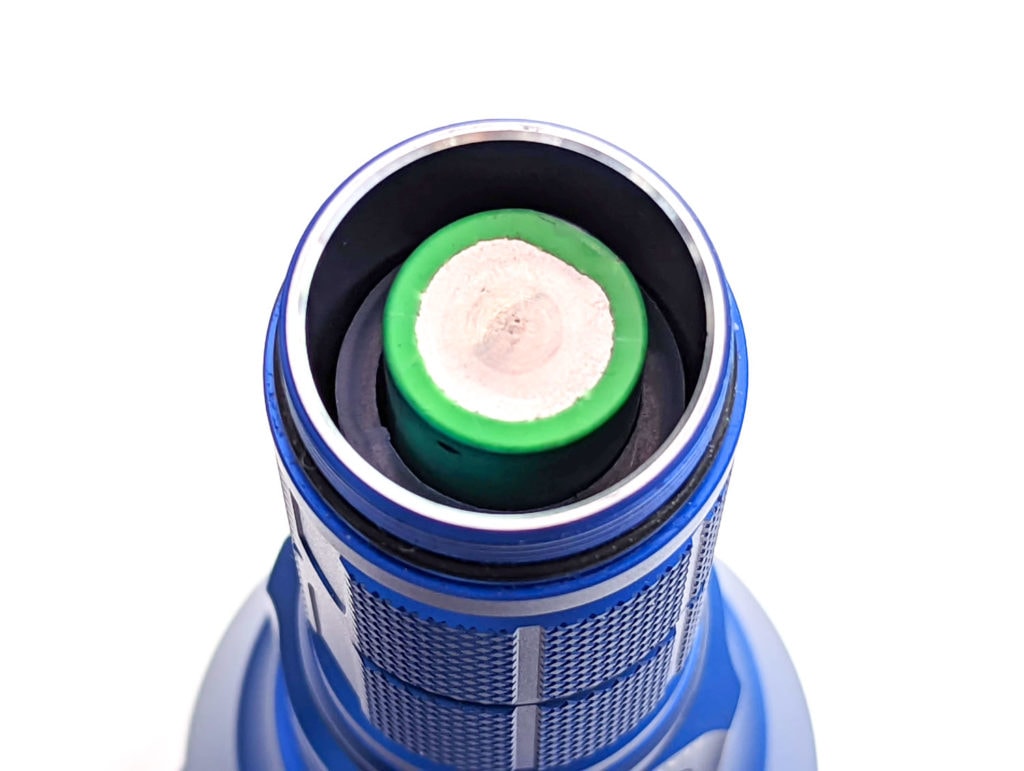
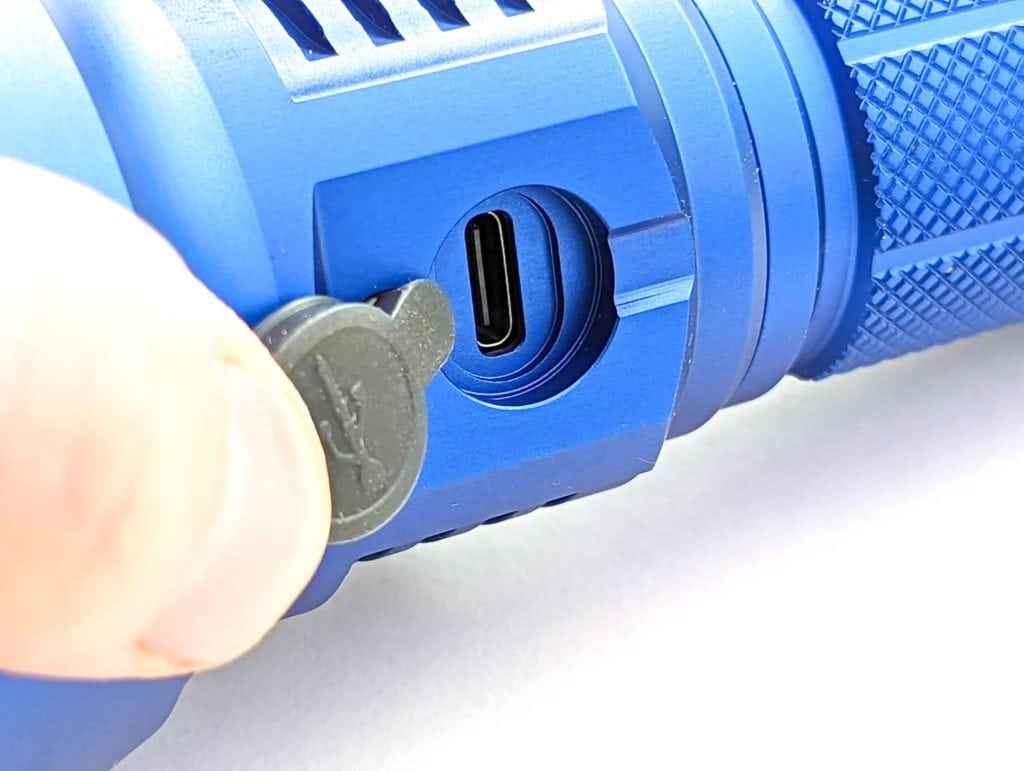
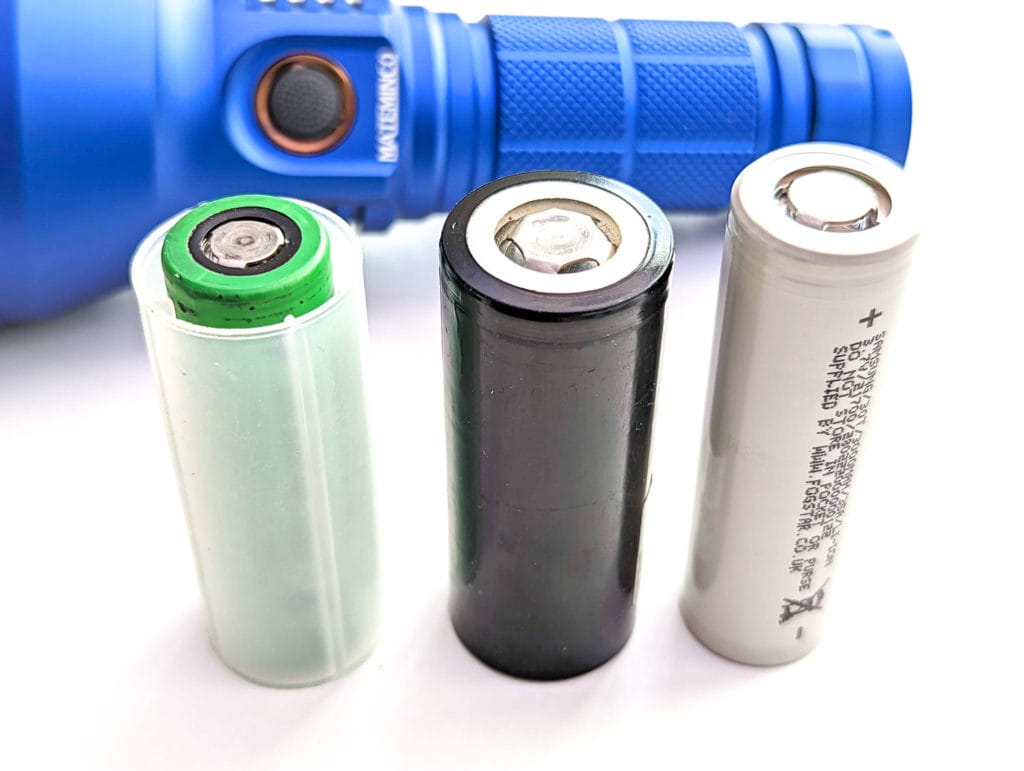
Performance test
Lux meter: All lux and lumen measurements are from my home made integrating sphere, calibrated with a S2+ measured by Maukka. Measurements are done with a UNI-T UT383S lux meter and Adafruit TSL2591 connected to a Raspberry Pi (using RuTiTe by bmengineer). Expect them to be within +/-10%.
DMM: Current readings were taken with a Precision Gold PG10B DMM for low currents and a Mustool X1 clamp meter for high currents.
I picked the highest drain cell I could find, a new 21700 30T. This is only 3000mAh, so won’t give great run times but gives the light the best chance to hit its specs. If you want the best run times then a 6000mAh 26650 cell would be best.
By default, the light comes in ramping brightness mode but I set it to stepped mode to get discrete modes for testing.
Lumen measurements (for each mode)
| Mode | Amps at start | Specs | turn on | 30 sec | 10 minutes |
|---|---|---|---|---|---|
| 1/7 | 12mA | 2 lm | 2 lm | – | |
| 2/7 | 66mA | 21 lm | 21 lm | – | |
| 3/7 | 0.25A | 68 lm | 68 lm | – | |
| 4/7 | 0.54A | 236 lm | 236 lm | 226 lm | |
| 5/7 | 1.90A | 953 lm | 212 lm | 881 lm | |
| 6/7 | 4.41A | 1994 lm | 1932 lm | 662 lm | |
| 7/7 | 8.7A | 3887 lm | 1234 lm | 665 lm | |
| Turbo | 19.7A* | 9300 | 6638 lm | 3215 lm | 550 lm |
| Turbo at 3.7V | 2836 lm |
I measured almost 20A with the light but at this current the wire and connection resistance is significant enough to make a difference, so I wouldn’t be surprised if it could take well over 25A.
Parasitic drain:
- 85 µA with the indicator light on
Runtime graph: Battery test
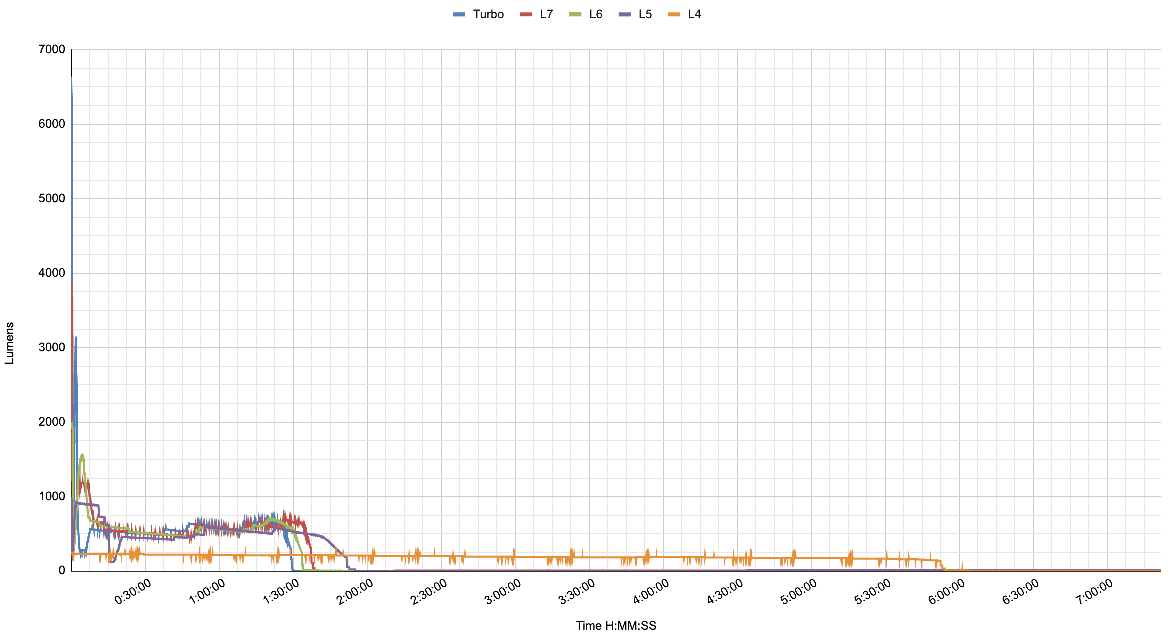
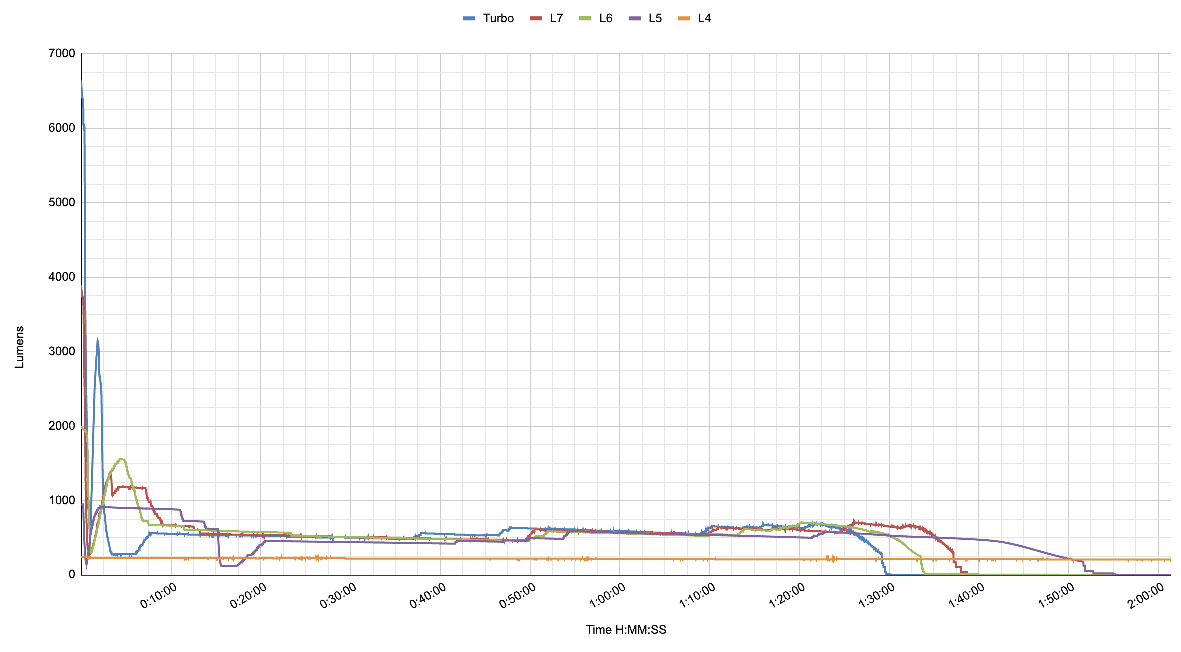
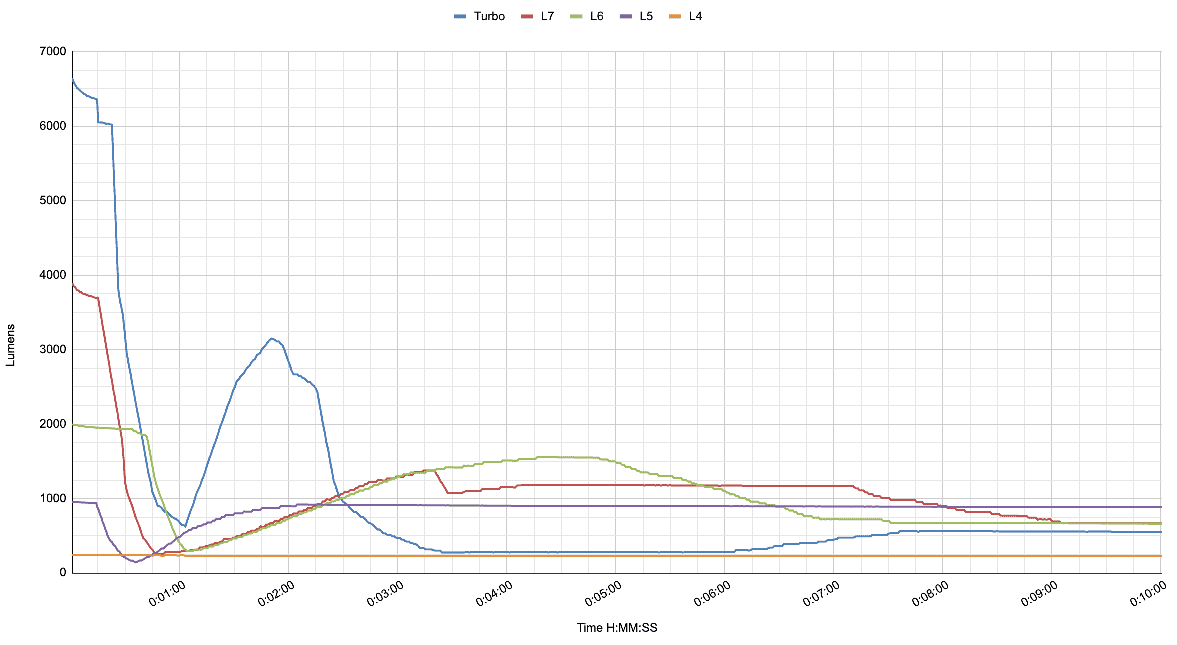
You can configure the light’s thermal limit to be higher but I left the Anduril thermal config as the default, as I expect 99% of people will. The driver was correctly calibrated and knew it was at 19 degrees room temperature to start with.
Turbo on the PD90S starts off at almost 7000 lumens and quickly drops: at a minute it’s already down to 650 lumens. It then creeps back up to 3000 lumens for a bit, before realizing it’s too hot again and dropping to 300, then settling around 600 at 10 minutes.
Level 7 starts at almost 4000 lumens, drops all the way down to 250 lumens after a minute. It goes back up to about 1000 lumens, then settles around 600 again.
Level 6 tells a similar story to level 7, though it starts off at 2000 lm.
Level 5 is around the brightness the light can sustain and after a little drop it remains fairly consistent.
As they all settle around 600 lumens, all the higher modes last for between 1h30 and 2h.
Level 4 is a steady 236 lumens and barely drops until around the 6 hour mark.
This is kind of what you should expect from a FET-driven hotrod like the PD90S. The driver firmware probably hasn’t been calibrated well for the host either, so instead of settling on a sustainable level quickly, it overshoots a couple of times.
Throw numbers:
Throw was measured at 10m at 30 seconds.
| Mode | Specified | Candela measured | Meters | Yards |
|---|---|---|---|---|
| 6/7 | – | 54,025 cd | 465 | 508 |
| 7/7 | – | 92,953 cd | 610 | 667 |
| Turbo @ 30s | 213750 cd / 924m | 102,934 cd | 642 | 702 |
| Turbo @ 0s | – | 181,164 cd | 851 | 931 |
Beamshots
The distance to the building is 170m. Photos were taken with a Pixel 6 Pro, set to 1/12s shutter speed and ISO 400, F1.85.
- Astrolux FT02S (SST40)
- Astrolux FT03 (XHP50.2)
- Mateminco PD90S
- Acebeam K30-GT
- Manker MC13 90.2
- Imalent RS50

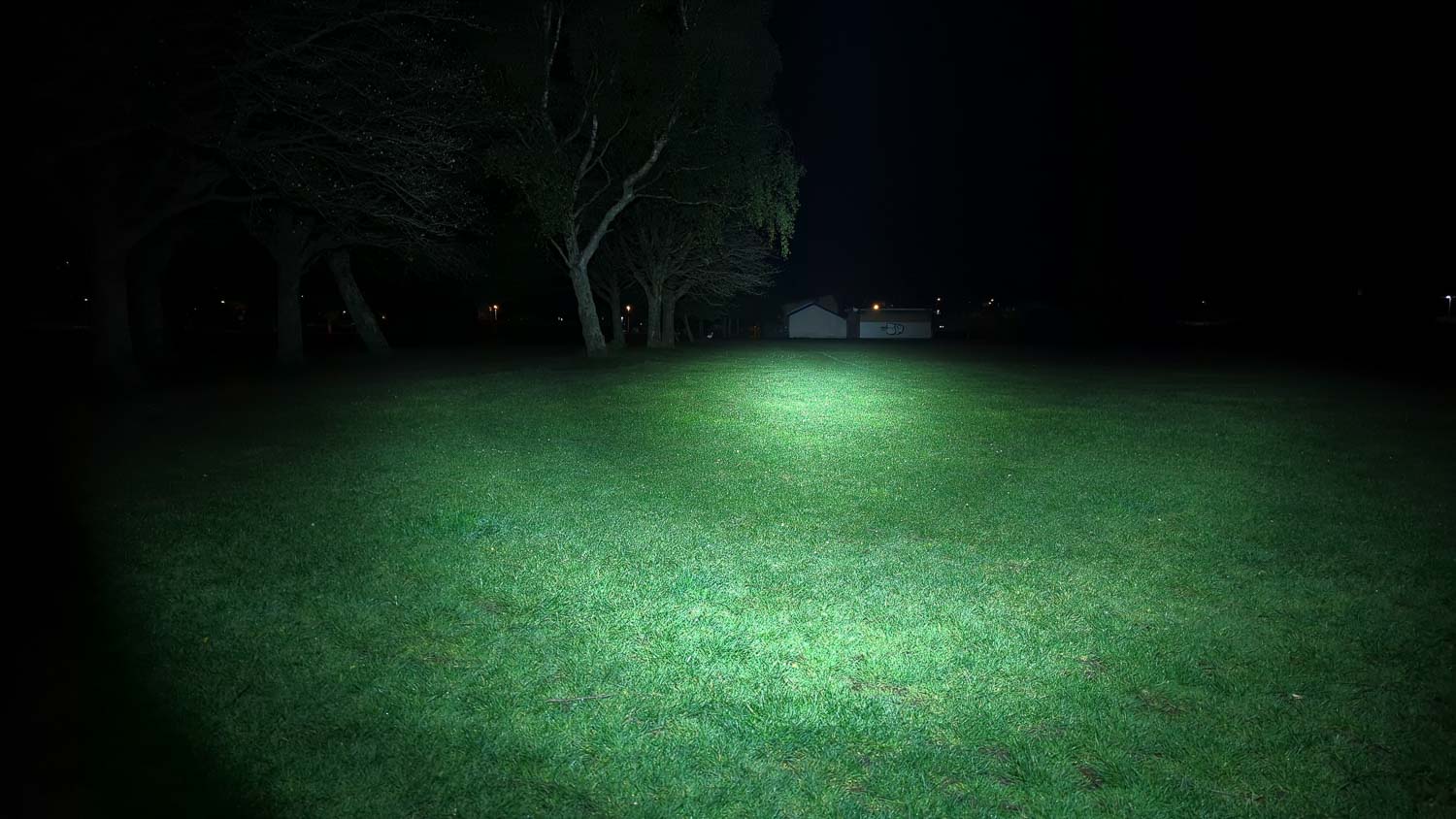
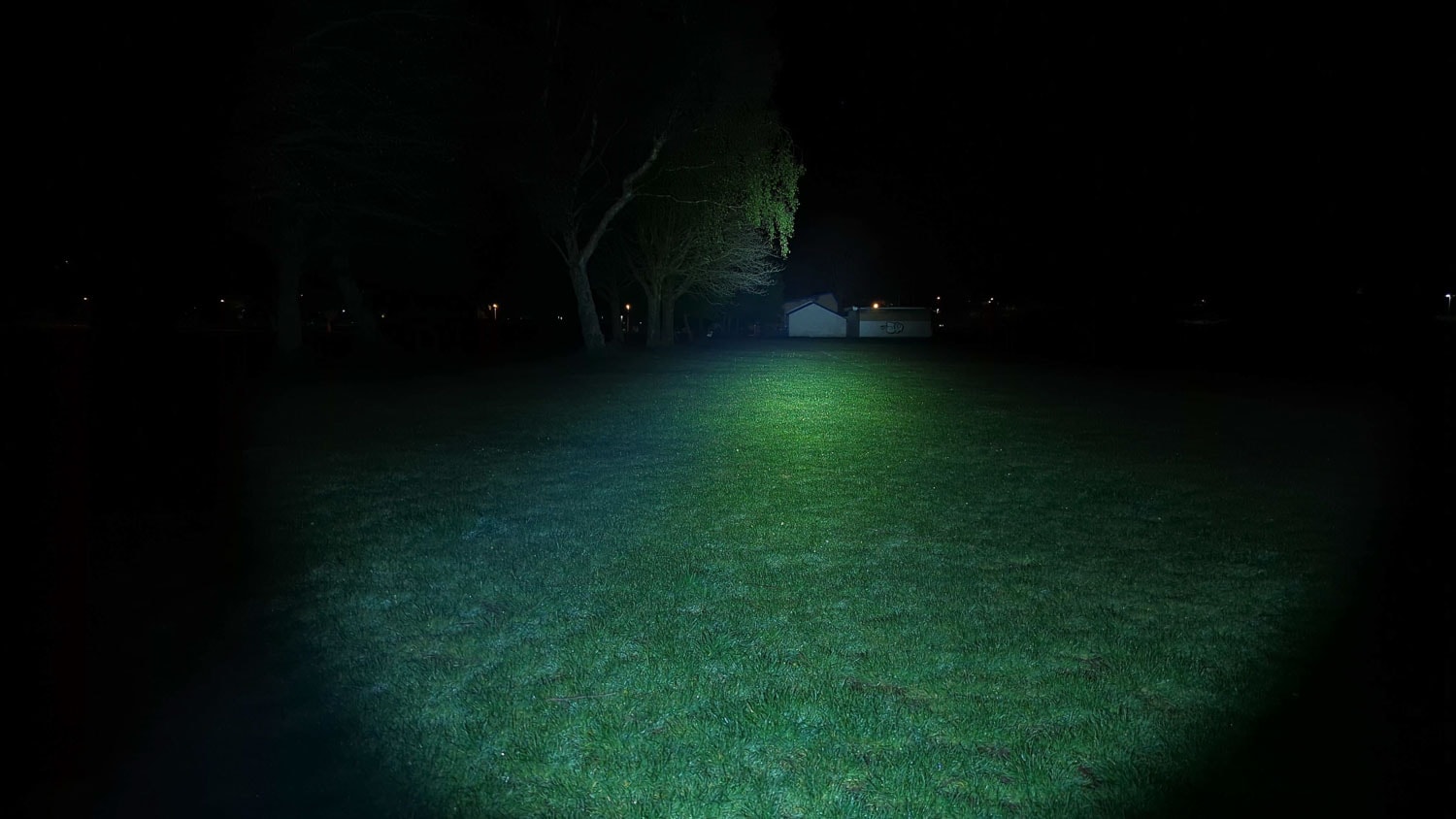

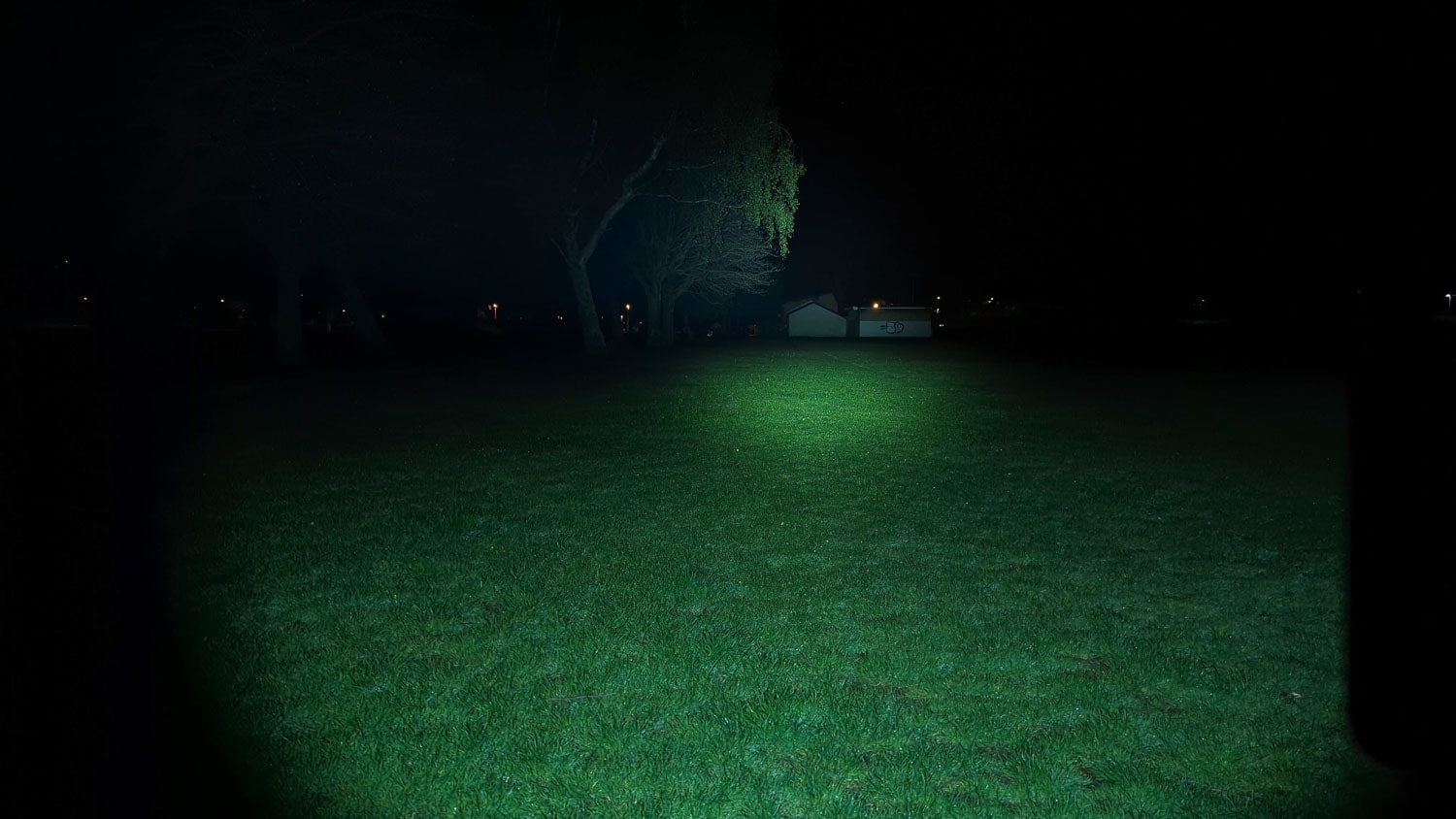
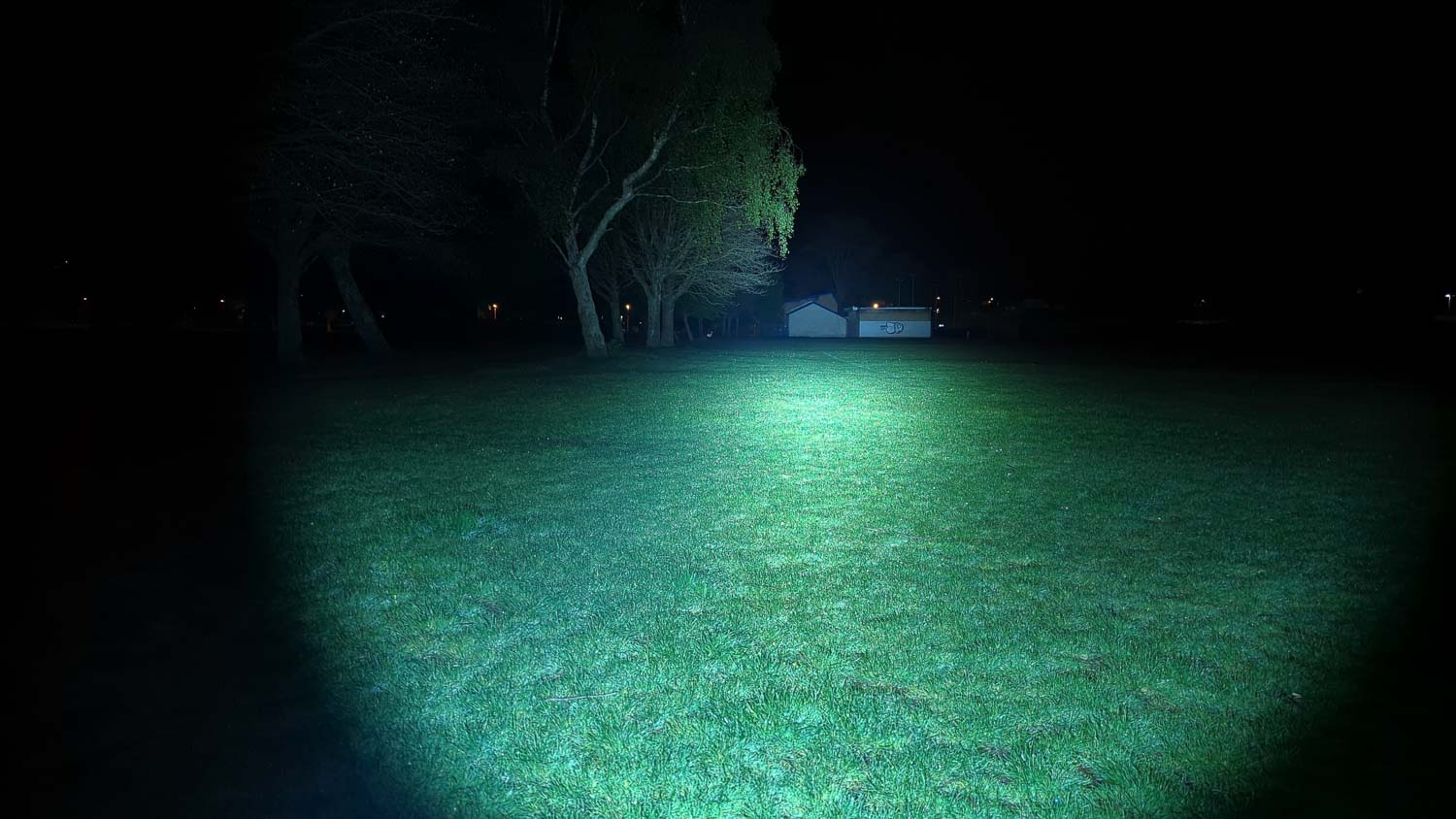
Disclaimer: This flashlight was sent to me for review at no cost by Mateminco. I have not been paid to review, nor have I been holding back on problems or defects.
Final Verdict
Pros
- Loads of lumens and still lots of throw
- Anduril and USB-C charging
Cons
- Only hits about 70% of specs at turn on
- Still uses an old version of Anduril and needs better thermal configuration
Explanation on star ratings:
1: Avoid: my phone flashlight would be a better choice – 2: Poor: significant defect or issues; almost unusable – 3: Average: some defects or issues; but still usable 4: Good: recommended (minor issues) – 5: Great: highly recommended

4 stars: ★★★★
The PD90S is the kind of light you can easily carry and with the Anduril UI it’s very flexible. Although it doesn’t hit the specs, its throw and brightness are still impressive. The combination of nearly 7000 lumens and 850m throw at turn on is more than any other single-cell light I know of.
The 2 cell Sofirn SP70 is about the same specs but much bigger. The only other lights that are as bright and throw as far are soda can style lights like the Lumintop GT3 and Acebeam K65.
I look forward to this host being used for more LEDs in the future.
Mateminco PD90 for sale
1lumen selects and reviews products personally. We may earn affiliate commissions through our links, which help support our testing.